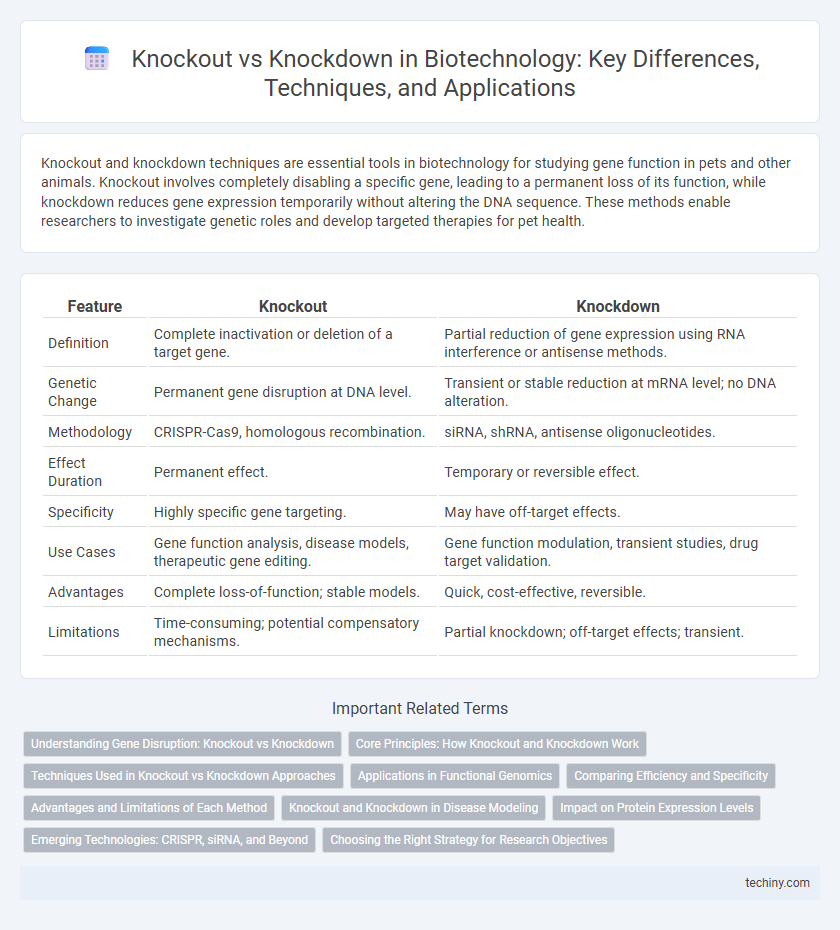Knockout and knockdown techniques are essential tools in biotechnology for studying gene function in pets and other animals. Knockout involves completely disabling a specific gene, leading to a permanent loss of its function, while knockdown reduces gene expression temporarily without altering the DNA sequence. These methods enable researchers to investigate genetic roles and develop targeted therapies for pet health.
Table of Comparison
| Feature | Knockout | Knockdown |
|---|---|---|
| Definition | Complete inactivation or deletion of a target gene. | Partial reduction of gene expression using RNA interference or antisense methods. |
| Genetic Change | Permanent gene disruption at DNA level. | Transient or stable reduction at mRNA level; no DNA alteration. |
| Methodology | CRISPR-Cas9, homologous recombination. | siRNA, shRNA, antisense oligonucleotides. |
| Effect Duration | Permanent effect. | Temporary or reversible effect. |
| Specificity | Highly specific gene targeting. | May have off-target effects. |
| Use Cases | Gene function analysis, disease models, therapeutic gene editing. | Gene function modulation, transient studies, drug target validation. |
| Advantages | Complete loss-of-function; stable models. | Quick, cost-effective, reversible. |
| Limitations | Time-consuming; potential compensatory mechanisms. | Partial knockdown; off-target effects; transient. |
Understanding Gene Disruption: Knockout vs Knockdown
Knockout and knockdown techniques are essential tools for gene disruption in biotechnology, each offering distinct mechanisms and effects on gene expression. Knockout involves complete removal or inactivation of a target gene, resulting in permanent loss of gene function, often achieved through CRISPR-Cas9 or homologous recombination. Knockdown reduces gene expression transiently or partially, typically using RNA interference (RNAi) or antisense oligonucleotides, allowing researchers to study gene function without permanent genetic alteration.
Core Principles: How Knockout and Knockdown Work
Knockout technology involves the complete inactivation or deletion of a specific gene, resulting in the permanent loss of gene function, typically achieved through CRISPR-Cas9 or homologous recombination. Knockdown reduces gene expression temporarily by targeting mRNA transcripts using RNA interference (RNAi) mechanisms such as siRNA or shRNA, decreasing protein production without altering the genomic DNA. Both methods are crucial for studying gene function, with knockout providing a stable genetic modification and knockdown enabling reversible and tunable gene suppression.
Techniques Used in Knockout vs Knockdown Approaches
CRISPR-Cas9 and zinc finger nucleases dominate knockout techniques by enabling precise gene disruption through targeted DNA cleavage. RNA interference (RNAi), employing siRNA or shRNA molecules, is the primary method for gene knockdown, reducing mRNA levels without altering the DNA sequence. Both approaches leverage distinct molecular tools to modulate gene expression at different regulatory stages for functional genomic studies.
Applications in Functional Genomics
Knockout techniques enable the complete inactivation of specific genes, providing definitive insights into gene function by observing phenotypic changes in organisms or cells. Knockdown methods, such as RNA interference (RNAi), reduce gene expression temporarily, allowing for the study of gene dosage effects and reversible functional analysis. Both approaches are essential in functional genomics, with knockouts offering a permanent solution for gene function elucidation, while knockdowns facilitate high-throughput screening and rapid gene function assessments.
Comparing Efficiency and Specificity
Knockout techniques, such as CRISPR-Cas9, provide high efficiency and complete gene disruption by permanently removing or altering target DNA sequences, leading to a total loss of gene function. Knockdown methods, like RNA interference (RNAi), offer partial gene suppression with variable efficiency and often exhibit off-target effects due to imperfect sequence complementarity. Comparing specificity, knockouts generally show greater precision in targeting specific genes, while knockdowns may result in unintended silencing of homologous genes, impacting overall experimental reliability.
Advantages and Limitations of Each Method
Knockout techniques provide complete gene elimination, enabling precise studies of gene function and typically resulting in permanent genetic changes, which is advantageous for creating stable models but can lead to compensatory biological effects and embryonic lethality. Knockdown methods, such as RNA interference, offer transient and partial reduction of gene expression, allowing for temporal control and reversibility, though they may suffer from off-target effects and incomplete suppression that limit interpretability. Researchers must weigh knockout's irreversible, all-or-nothing impact against knockdown's flexibility and potential variability when choosing the appropriate method for functional genomics studies.
Knockout and Knockdown in Disease Modeling
Knockout techniques involve complete gene inactivation, enabling precise modeling of genetic diseases by fully eliminating target gene functions, which helps in understanding gene roles and pathogenesis. Knockdown approaches reduce gene expression levels without entirely abolishing function, allowing the study of partial gene activity effects and mimicking conditions with hypomorphic mutations or gene dosage variations. Both knockout and knockdown models are crucial tools in disease research, facilitating drug target validation, phenotypic analysis, and therapeutic strategy development.
Impact on Protein Expression Levels
Knockout techniques completely eliminate the target gene, resulting in the total absence of the corresponding protein, which allows for clear assessment of its biological function. Knockdown methods reduce gene expression by degrading mRNA or blocking translation, leading to partial protein depletion and enabling studies on dosage effects. These differences in protein expression levels critically influence experimental outcomes and the interpretation of gene function in biotechnology research.
Emerging Technologies: CRISPR, siRNA, and Beyond
CRISPR technology enables precise gene knockout by introducing targeted DNA double-strand breaks, leading to permanent gene disruption, while siRNA facilitates gene knockdown through post-transcriptional gene silencing, reducing mRNA levels transiently. Emerging biotechnologies such as base editors and prime editors expand the toolkit beyond traditional CRISPR and siRNA, offering refined control over gene expression and modification. These advances accelerate functional genomics and therapeutic development by enabling customizable and efficient modulation of genetic targets.
Choosing the Right Strategy for Research Objectives
Knockout technology permanently disables a gene, offering complete loss-of-function ideal for studying gene roles in development or disease. Knockdown techniques utilize RNA interference or antisense oligonucleotides to transiently reduce gene expression, allowing reversible and tunable investigations. Selecting between knockout and knockdown approaches depends on the necessity for permanent gene loss versus temporary suppression to align with specific experimental goals and timelines.
Knockout vs Knockdown Infographic

 techiny.com
techiny.com